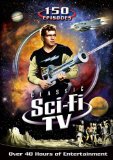| Reviews & Columns |
|
Reviews DVD TV on DVD Blu-ray 4K UHD International DVDs In Theaters Reviews by Studio Video Games Features Collector Series DVDs Easter Egg Database Interviews DVD Talk Radio Feature Articles Columns Anime Talk DVD Savant Horror DVDs The M.O.D. Squad Art House HD Talk Silent DVD
|
DVD Talk Forum |
|
|
| Resources |
|
DVD Price Search Customer Service #'s RCE Info Links |
|
Columns
|
|
|
Classic Sci-Fi TV - 150 Episodes
Mill Creek // Unrated // January 27, 2009
List Price: $29.98 [Buy now and save at Amazon]
Ever since buying a few cheap DVDs from Madacy in the late 90's I've been very leary of public domain releases. They're very hit or miss as far as quality goes, more often miss than hit. I've purchased or received review copies of films where the video quality in literally unwatchable or several minutes are missing from the narrative. (Not edited out, but just missing... I remember one film where two people were talking in a cafe and then there's a mid-sentence jump cut to a scene many minutes later.) When I had the chance to review Mill Creek's Classic Sci-Fi TV - 150 Episodes collection it was with a bit of trepidation that I took the assignment. The fact that this set contains some great shows that I would love to have in my collection was the deciding factor. There are some very rare shows contained in this set such as a 1958 Hammer produced pilot for a weekly horror show Tales of Frankenstein, nearly a complete collection of Captain Z-RO, a nearly forgotten 50's SF show, two different pilots based on the pulp hero The Shadow, an early Christopher Lee appearance, Gene Autry's first staring role in the genre-blending serial the Phantom Empire (all 12 chapters are included) as well as a dozen episodes of Flash Gordon, episodes of Rocky Jones Space Ranger, Lights Out, One Step Beyond, and the list goes on and on. Though the A/V quality is mediocre for most of the set, there are some standout shows that look and sound great and none of them are so bad as to be unwatchable. When all is said and done, Mill Creek has put out quite an impressive and worthwhile set.
Disc One - Flash Gordon (1954) - 12 episodes:
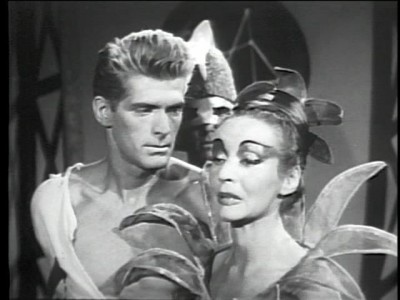 Based on the popular comic strip, this show only lasted a single season, which is a little surprising. Though the production values were very low, they weren't significantly inferior to some of the other SF shows of the time that gained more fame.
Based on the popular comic strip, this show only lasted a single season, which is a little surprising. Though the production values were very low, they weren't significantly inferior to some of the other SF shows of the time that gained more fame.
Oddly enough, this was an international co-production with German, French, and US companies picking up the tab. It was filmed in West Berlin and Marseilles, and it's interesting to see these cities so shortly after the conclusion of WWII. There were still many bombed out buildings to be seen in the background and it actually gave the show a unique look.
Though the characters are the same, the show departs from the Alex Raymond strip in a lot of ways. In this show Flash, Dale, and Dr. Zarkov are agents of the Galactic Bureau of Investigation and travel the universe battling evil doers in their space ship the Sky Flash.
The scripts are good and the program is a lot of fun.
The episodes included on this disc are (though not in this order):
Episode 1: Planet of Death
5. Akim the Terrible
6. The Claim Jumpers
8. The Breath of Death
10. Return of the Androids
17. Lure of Light
19. Race Against Time
20. The Witch of Neptune
21. The Brain Machine
22. Struggle to the End (3)
25. The Forbidden Experiment
And continued on Disc Two:
36. Deadline at Noon
39. The Subworld Revenge (The last episodes)
D isc Two:
Space Angel (1962):
Set in the not too distant future, this SF children's program centers around Scott McCloud who is secretly the effeminate sounding Space Angel. He commands the space ship Starduster which is manned by Taurus, the mechanic with an unbelievable Irish accent, and Crystal the navigator/ science expert. On Earth is Dr. Mace, Crystal's father and the inventor of many of the gadgets that McCloud uses. He's available for a quick video-phone call when things get tight and always has the answer to any problems the crew faces.
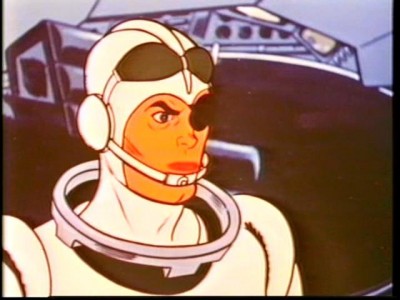 The program was presented in color, and was the second show to come from Cambria Productions. The company is best known for their so-bad-its-good 'cartoon' Clutch Cargo. That show was only a cartoon in the most basic sense. There was almost no animation at all. Instead of having to do to the cost and expense of animating lip movements, the lips of the voice actors were superimposed over the static facial images (using the company's patented Synchro-Vox technique.) Actor's hands would be filmed turning dials and opening doors, cardboard cutouts would slide across the frame to illustrate movement and cigar smoke was blown in front of the camera lens to create fog.
The program was presented in color, and was the second show to come from Cambria Productions. The company is best known for their so-bad-its-good 'cartoon' Clutch Cargo. That show was only a cartoon in the most basic sense. There was almost no animation at all. Instead of having to do to the cost and expense of animating lip movements, the lips of the voice actors were superimposed over the static facial images (using the company's patented Synchro-Vox technique.) Actor's hands would be filmed turning dials and opening doors, cardboard cutouts would slide across the frame to illustrate movement and cigar smoke was blown in front of the camera lens to create fog.
Space Angel uses the same technique, but the people at Cambria improved the technique significantly after their experiences with Clutch. First and foremost they added make-up around the actor's lips to match the color of the drawn characters. The jarring, surreal white lips of Clutch were replaced with something that at least matched. They also de-emphasized the technique to a large extent, rarely showing the moving lips in close up. The final improvement was that they used the technique sparingly. The person talking was often facing away from the camera or had his mouth covered by a space helmet.
Initially run from 1962-64, this shows was surprisingly sophisticated given the time constraints and audience. The stories incorporated some real science on occasion (when landing on a planet in one episode, the crew leaves the mother ship in orbit and takes a lander down to the planet, a pretty advanced idea in 1962) and the plots, while simple, never talked down to children. The characters used futuristic terms realistically, as if they've been using them for years and never just added the term "space" in front of a word to make it sound advanced. Many SF shows at this time felt the need to define all of the terms in the same sentence that lead to awkward and unrealistic lines like "Hand me the space wrench, a tool that can open the stuck hatch in an instant!" Space Angel gets kudos for avoiding such muck.
This was a syndicated show, and each story was comprised of five episodes each running five-minutes. Stations could show one a day Monday through Friday or group them together and program them as a half-hour block. The stories presented here are stitched together into 30 minute episodes without the credits interrupting every few minutes.
The stories included in this set are:
Power Failure
Scratch One Chimp
The Gladiators
They Went That Away
Cosmic Combat
The Light Barrier
Expedition to a New Moon,
The Donovan Plan
Visitor from Outer Space
Climax (1955):
The set only has a single episode from this 1950's hour-long series, but what an episode: Dr. Jekyll and Mr. Hyde adapted by Gore Vidal and staring Michael Rennie (The Day the Earth Stood Still). Broadcast live, this rare kinescope is a great addition to anyone's SF TV collection.
The Star and the Story (1955):
The first episode of this 1/2 hour long drama is included, a story called The Dark Stranger staring Edmond O'Brien (The Barefoot Contessa for which he won an Oscar and the Film Noir classic D.O.A.) In this thriller O'Brien plays a writer who specializes in crime stories, but his fiction starts to ring true when his latest book starts to be played out, and he's in the role of the killer.
Disc Three and Four: Captain Z-RO (1955):
Like Flash Gordon, this was a very low budget Sci-Fi show that I really enjoyed. Located in a hidden laboratory somewhere on Earth, Captain Z-Ro (pronounced "Zero") conducted "experiments in time and space!" Though it was a SF show, the stories had a historical content, like early episodes of Doctor Who. In most cases Captain Z-RO would locate some nefarious plot in the distant past and go back in time to help the good guys. He saves the Pony Express from a rival stagecoach firm, helps get the Magna Carta signed, and they even aid a certain thief to escape from a trap set by the Sheriff of Nottingham.
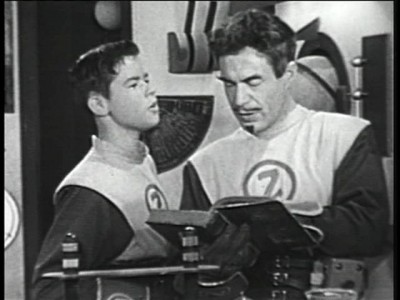 Occasionally the shows would have a more typical SF theme, such as when Z-RO invents a robot to explore the planet Mercury. Unfortunately a lightning strike right at the minute of transportation sends the robot to San Francisco instead of the nearby planet and scrambles its electronic brain in the process. Much of the show is taken up watching the robot walk around SF and occasionally causing trouble. Though the production values were very low (it looks like it was filmed in someone's decorated garage) the show had a lot of spirit and was fun to watch.
Occasionally the shows would have a more typical SF theme, such as when Z-RO invents a robot to explore the planet Mercury. Unfortunately a lightning strike right at the minute of transportation sends the robot to San Francisco instead of the nearby planet and scrambles its electronic brain in the process. Much of the show is taken up watching the robot walk around SF and occasionally causing trouble. Though the production values were very low (it looks like it was filmed in someone's decorated garage) the show had a lot of spirit and was fun to watch.
This disc presents 24 or the 26 filmed episodes of this show. (Arrgh! So close!)
1: Christopher Columbus
2: Daniel Boone
3: Marco Polo
4: Benedict Arnold
5: King John
6: Magellan
7: Pony Express
8: William Tell
9: Roger the Robot
10: Blackbeard the Pirate
11: Attila the Hun
12: Robin Hood
13: Washington and Howe
15: Hernando Cortez
16: Molly Pitcher
17: Discovery of Gold
18: Meteor
20: Aztec Papers
21: Genghis Kahn
22: The Great Pyramid
23: Leonardo DaVinci
24: William the Conqueror
25: Adventure in Space
26: King Alfred
Disc Five:
The main reason I wanted to review this set is for the shows on this disc. There is a wonderful compilation of very rare shows and pilots, many that I had only heard about but never seen.
Here Comes Tobor (1956): This is the pilot for a proposed TV series based on the movie Tobor the Great. It was created by the same production company, Dudley Pictures, and many of the people who worked on the film contributed to this episode. The only person to appear in the movie and the series is the robot himself, Tobor, they carried the themes from the film over to the small screen. The large and powerful robot is controlled psychically by a small boy, and in this episode they have to rescue an atomic submarine that has been taken over by the enemy. It's corny but a lot of fun, sort of like the film itself.
Tales of Frankenstein (1958): This is another rare pilot that I had seen still from, but never the whole show. It was created by Hammer Films, and ironically featured a monster that looked at lot like Universal's Frankenstein monster.
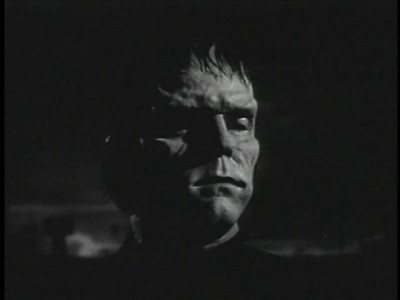 A terminally ill man and his wife travel to Dr. Frankenstein in search of his help. He's the only one who could possibly save the young man's life. Unfortunately the doctor has other plans. He needs a fresh, young brain for his creation, and if he just waits for a short while, the man who came seeking his aid will provide it.
A terminally ill man and his wife travel to Dr. Frankenstein in search of his help. He's the only one who could possibly save the young man's life. Unfortunately the doctor has other plans. He needs a fresh, young brain for his creation, and if he just waits for a short while, the man who came seeking his aid will provide it.
This was a great show! It had an eerie atmosphere that was very reminiscent of the best Universal horror moves an intriguing plot that painted Dr. Frankenstein in a wonderfully evil light. After reading about this show in Famous Monsters decades ago, I was glad to finally get a chance to see it and very happy that it lived up to my expectations.
The Shadow - The Invisible Avenger (1958): This pilot tried to bring the popular pulp hero to the small screen, but failed. Running at about an hour, I'm sure it's the only two episodes that were filmed stitched together to make a B-level film. In this story Lamont Cranston (Richard Derr) and his mystic teacher Jogendra (Mark Daniels) head to New Orleans to find a missing friend. While there they stumble upon a plot to kill the leader of a rebellion against a South American dictator. There's some good jazz music in this film, and Derr did a good job as Cranston, but the story was very weak and there were more than a few plot holes. Overall this is a nice curiosity.
Clutch Cargo (1959) - This cartoon, if you can call it that, is famous for taking limited animation to a whole new level. There is virtually no traditional cell animation this show; instead human mouths are superimposed over drawn faces to 'animate' their speech. A program that has gone down in history as the absolutely worst looking cartoon ever, it's inclusion here is good for a laugh. You really have to see it to believe it.
In the adventure presented here, Operation Moonbeam, Clutch, Spinner, and the dog Paddlefoot pilot a rocket to the moon in order to win a lucrative rocket contract for one of their friends.
Johnny Jupiter (1953) - This is from the show's second incarnation that was broadcast on ABC (the first Johnny Jupiter was on the Dumont Network and though the creative cast was the same, the premise was altered significantly.) In this version Ernest P. Duckweather (Wright King) is a young inventor who works at the neighborhood hardware store. While tinkering in his lab one day, he manages to contact creatures (puppets) on the planet Jupiter, Johnny Jupiter, Major Domo, and Reject the Robot.
This was more of a sitcom than a SF show. In the single episode presented here Duckweather has to convince the host of a popular radio show to give a lecture to a local civics group. The host agrees, but when Duckweather finds out the man wants a $1000 fee, he dresses up as the famous speaker and goes on himself. The creatures from Jupiter play a minor role, giving Ernest advice when he needs it. Though the jokes weren't funny and the puppets pretty lame even for the time, it was an interesting show to watch.
Your Jeweler's Showcase: Operation E.S.P. (1952) - This is fun (and rare) program that stars Sheldon Leonard (Nick the bartender from It's a Wonderful Life) as Hardwick Harris. Harris is a hobo, riding the rails from location to location, but every Christmas Eve, no matter where he is, the local post office will have a general delivery letter for him containing $50. This year the sheriff finds it a little strange that Harris doesn't even know the name of the city he's in and yet has mail waiting. He runs him in, in a bid to keep his freedom Hardwick tells the story of a short order cook in a diner he once met who could see into the future.
This is a very fun and cute tale with a few good laughs. Yes, it's easy to see the ending way in advance, but just getting there is most of the fun.
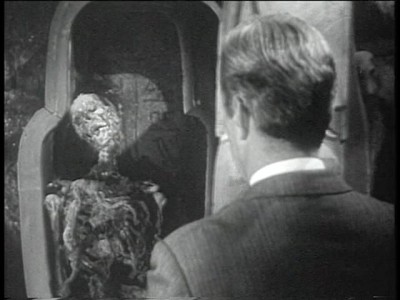 Thriller - The Return of Andrew Bentley (1961): Richard Matheson adapts a story by August Derleth in this excellent installment of the program that was hosted by Boris Karloff. John Newland stars as Ellis Corbett, a man summoned by his eccentric uncle. The man promises to leave Corbett his house, estate, and vast fortune if, and only if, Ellis will check his tomb every day and make sure it hasn't been opened. Ellis agrees, and that evening his uncle takes his own life. That's when Ellis' troubles begin as a black magician and his demon familiar are trying to steal his uncle's body for nefarious purposes. Dark, moody, and suspenseful, this episode is one of the best installments of Thriller I've seen.
Thriller - The Return of Andrew Bentley (1961): Richard Matheson adapts a story by August Derleth in this excellent installment of the program that was hosted by Boris Karloff. John Newland stars as Ellis Corbett, a man summoned by his eccentric uncle. The man promises to leave Corbett his house, estate, and vast fortune if, and only if, Ellis will check his tomb every day and make sure it hasn't been opened. Ellis agrees, and that evening his uncle takes his own life. That's when Ellis' troubles begin as a black magician and his demon familiar are trying to steal his uncle's body for nefarious purposes. Dark, moody, and suspenseful, this episode is one of the best installments of Thriller I've seen.
The Shadow (1955): Another pilot for a Shadow TV show that never took off. Not quite as enjoyable as the 1958 version on this disc, but still fun. This time Lamont Cranston is a psychologist on retainer with the police department. Along with his girlfriend Margo Lane, Cranston investigates the Kimono murder. In this case a woman answers the door and is murdered. Her boyfriend is the prime suspect, but Lamont thinks something strange is going on.
This was a more standard police mystery with the Shadow only adding to it a bit. A good tyr, but one destined to fail.
Destination Space (1959): In this pilot Harry Townes plays Jim Benedict the engineer who both runs and designed America's first space station. When a solar flair causes significant damage to the station, Benedict has to travel back to Earth to fight congress for funds to keep the station operational.
This is one of those shows where you have to wonder what they were thinking. After a short but exciting opening when the station gets damaged, the next 20 minutes are spent watching Benedict trying to convince congressmen how important the space station is. Terribly boring and drawn out, it's no surprise that this wasn't picked up.
Stamp Day for Superman (1954): The cast and crew of The Adventures of Superman donated their services to the US Government for this half hour adventure. Lois is kidnapped and held by jewel thieves and it's up to Superman to save her and get to a high school in time for his appearance to sell US Saving Stamps.
Disc Six: One Step Beyond (1959-1961):
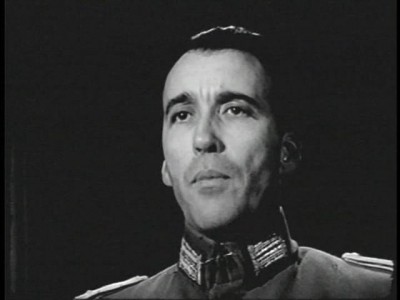 An unlucky 13-episodes from this anthology series hosted by John Newland that explored the paranormal. Each story, supposedly true, revolves around a ghost or some psychic ability. This was never my favorite show and seeing these episodes once again reminds me why: The stories are pretty poor and the only thing that makes them interesting is the implication that they really happened. The wild coincidences make for poor drama, and if you have a hard time swallowing that psychic abilities really exist, there's not a lot that this show offers.
An unlucky 13-episodes from this anthology series hosted by John Newland that explored the paranormal. Each story, supposedly true, revolves around a ghost or some psychic ability. This was never my favorite show and seeing these episodes once again reminds me why: The stories are pretty poor and the only thing that makes them interesting is the implication that they really happened. The wild coincidences make for poor drama, and if you have a hard time swallowing that psychic abilities really exist, there's not a lot that this show offers.
The episodes are:
The Sorcerer (with Christopher Lee... a small bit of footage seems to be missing)
Encounter
House of the Dead
Epilogue
The Stone Cutter
Contact
The Gift
Bride Possessed (the first episode)
The Burning Girl
The Premonition
Forest of the Night
Reunion
The Haunting
Where are They
Goodbye Grandpa
The Riddle
Discs Seven and Eight: Rocky Jones Space Ranger 23 episodes (1954):
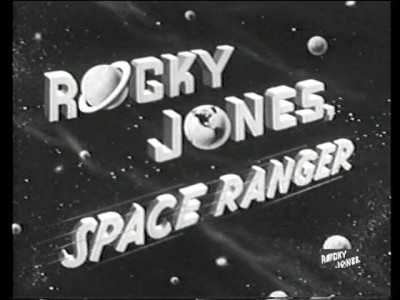 There is a good chunk of Rocky's adventures presented here, 23 out of the 39 filmed episodes. Set in the year 2054, Rocky, his co-pilot Winky (played by the tragic actor and former Our Gang star Scotty Beckett, later replaced by James Lydon (as Biff) when Beckett fled the country to avoid a weapons charge) and his pals Vena, Professor Newton and Bobby fly through space in their rocket ship protecting Earth from the evil mechanizations of villains such as Queen Cleolanthe of Ophiuchus who alternately wanted to kill Rocky and mate with him, and the evil Space Ranger Griff.
There is a good chunk of Rocky's adventures presented here, 23 out of the 39 filmed episodes. Set in the year 2054, Rocky, his co-pilot Winky (played by the tragic actor and former Our Gang star Scotty Beckett, later replaced by James Lydon (as Biff) when Beckett fled the country to avoid a weapons charge) and his pals Vena, Professor Newton and Bobby fly through space in their rocket ship protecting Earth from the evil mechanizations of villains such as Queen Cleolanthe of Ophiuchus who alternately wanted to kill Rocky and mate with him, and the evil Space Ranger Griff.
This show is a lot like Space Patrol. The stories are simple but fun and while the scripts won't win any awards the program does bring out the kid in you. The special effects are actually quite good for a low budget show from the 50s too. My only regret is that all 39 episodes weren't included in this set.
There is a bug in the lower right hand corner, consisting of the Rocky Jones logo. Presumably this is to cover the source of the video.
The episodes included are:
Beyond the Curtain of Space Episodes 1-3 (where Rocky first meets Vena, Professor Newton and Bobby)
Escape into Space
Pirate of Prah 1-3
Crash of the Moons 1-3
Silver Needle in the Sky 1-3
The Forbidden Moon 1-3
Bobby's Comet 1-3
Rockey's Odyssey 1-3
Kip's Private War
Disc Nine: Phantom Empire Episodes 1-12 (Complete):
The three of the last four discs all contain movie serials. While these aren't technically TV shows, I'm not going to split hairs. The Phantom Empire is not the best serial to ever come out of Hollywood (that honor arguably goes to The Adventures of Captain Marvel) but it is one of my all-time favorites. This Mascot serial has it all, I guess they figured if they threw in everything including the kitchen sink everyone would be happy. As it is, the serial is a mess but a fun mess.
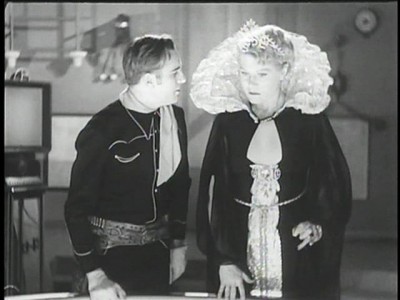 Gene Autry stars as himself in his first staring role. He's the half-owner of Radio Ranch and has to broadcast a daily radio show from the ranch (which pretty much consists of him singing one song) or else he'll loose his land. When a professor and his daughter arrive at Radio Ranch looking for deposits of Radium, Gene agrees to help look and discovers the secret civilization of Murania, located 25,000 feet below ground. Murania is a technologically advanced country, the survivor of the lost island civilization of Mu, which is ruled by the voluptuous Queen Tika. When Tika finds out that Gene has discovered her country she orders her soldiers (and robots) to kill him. Add in some dishonest crooks who want the radium for themselves and you've got an exciting serial.
Gene Autry stars as himself in his first staring role. He's the half-owner of Radio Ranch and has to broadcast a daily radio show from the ranch (which pretty much consists of him singing one song) or else he'll loose his land. When a professor and his daughter arrive at Radio Ranch looking for deposits of Radium, Gene agrees to help look and discovers the secret civilization of Murania, located 25,000 feet below ground. Murania is a technologically advanced country, the survivor of the lost island civilization of Mu, which is ruled by the voluptuous Queen Tika. When Tika finds out that Gene has discovered her country she orders her soldiers (and robots) to kill him. Add in some dishonest crooks who want the radium for themselves and you've got an exciting serial.
The thing I like about this adventure is the genre blending nature of the show. There are horse chases (with the Murania's looking like KKK members running off to a rally), robots, ray guns, aerial dog fights, and plenty of fisticuffs. Yes, it ludicrous when Gene sneaks into Murania and is about to discover something important only to announce "Hey guys we've got to get back to Radio Ranch and do the show or I'll loose the spread!" The only singing cowboy science fiction lost civilization serial ever made, it's well worth checking out. What makes this disc even better is that the picture quality is excellent, well above the other shows in this set.
Disc Ten: The Undersea Kingdom (1936) Chapters 1-12 (Complete):
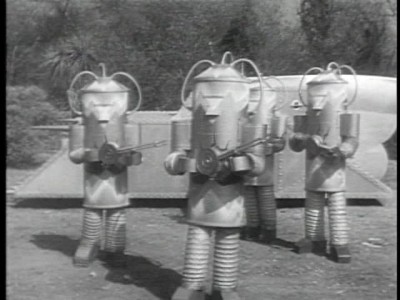 This was only the second serial Republic produced but it's clear that they knew what they were doing. Filled with action, adventure and excitement, The Undersea Kingdom is a classic.
This was only the second serial Republic produced but it's clear that they knew what they were doing. Filled with action, adventure and excitement, The Undersea Kingdom is a classic.
The story, what little there is of it, involves top Annapolis student Crash Corrigan (Ray Corrigan who took the name "Crash" from this serial) going on a expedition with Professor Norton (C. Montague Shaw) in his newly invented atomic powered submarine to find the source of a series of recent earthquakes. A reporter, Diana Compton (Lois Wilde) tags along as does Norton's son Billy (Lee Van Atta) an assistant Joe (John Bradford) and Briny (Smiley Burnette) and Salty (Frankie Marvin), the comic reliefs.
Once under the sea they discover that the earthquakes are being caused by villains from the lost city of Atlantis. The fabled city is in the midst of a civil war between a war-like faction who wants to take over the surface world and the peace-loving group that just wants to leave things as they are. It's easy to tell these two groups apart because the war mongering faction wears black robes and the peaceful group wears white. It's up to Crash and his companions to make sure the white capes win and the stop the nefarious plans of the black capes.
While there are a lot of 'cheats' in this serial (as there are in Phantom Empire and Radar Men from the Moon) it's still a fun show. Just the idea of a ultra-advanced civilization that has harnessed nuclear power and created a race of robots going into battle on horseback and fighting with swords is great. Corny as hell, but it gives the opportunity for a lot of great horse stunts. I'll admit there were several times I was hoping that someone would shoot Briny and Salty, but nothing's perfect I suppose.
Disc Eleven:
Tales of Tomorrow (1951-53) 6 Episodes:
This is an excellent series that presented some solid SF stories every week. There's more SF than horror, and the tales weren't necessarily aimed at children. Test Flight was reminiscent of Heinlein's The Man Who Sold the Moon, concerning a man obsessed with being the first into space and therefore being able to control space travel. It has an interesting twist at the end. All of these episodes are good, (though Verdict in Space drags at the beginning) and worth owning.
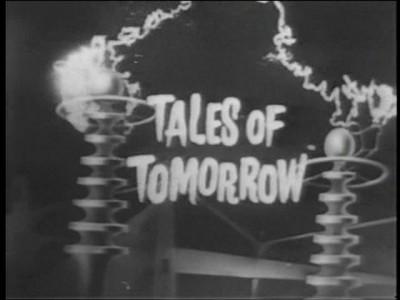 The episodes contained in this set are:
The episodes contained in this set are:
Verdict in Space (the first episode)
Blunder
What We Need (a wonderful 'magical shop' story)
Age of Peril
Sneak Attack
Test Flight
Lights Out (1946-1952) 4 Episodes:
This long running series was one of a handful of shows to make the transition from radio to television and managed to snare some good writers and an impressive cast for most shows. The quartet of episodes included here are about average for the show, they'll hold your attention and it's fun to see some of the actors in early television. Unfortunately these were broadcast live and all that remains are kinetescopes. The image quality of these shows are below average for this set.
The episodes included are:
What Just Happened (with John Howard)
Curtain Call (Otto Kruger)
Man with the Watch (Francis L. Sullivan)
Passage Beyond
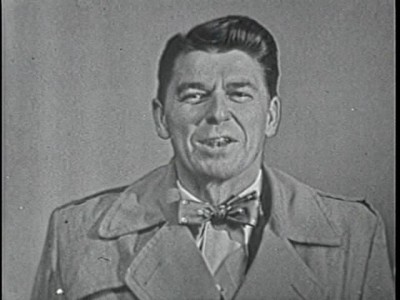 G.E. Theater 2 episodes:
G.E. Theater 2 episodes:
Hosted by Ronald Regan, this program ran for a decade and was one of the first early TV hits. The two stories presented here (the first one staring Reagan) aren't really SF, though the second one comes closest. In Let it Rain Reagan is a reported who stops into a small southern town for a short vacation and falls in love with a local girl. The Ballad of Mender McClure is a bit more interesting. A grumpy, mean, old man is given a jug full of a magical potion that will heal any illness. How does he use it, and how does it affect him? Vincent Price plays the devil and does a wonderful job.
Disc Twelve:
Radar Men from the Moon 12 episodes (1952):
This chapter play was produced at the end of the serial era and it's obvious that the glory days had passed. The first Commander Cody serial and reused the same outfit from an earlier Republic serial, King of the Rocket Men (1949). (It would be followed by "Commando Cody: Sky Marshal of the Universe" (1955). In between the suit would also star in "Zombies of the Stratosphere" (1952).) Unfortunately, that's not the only thing it reuses, as it includes a lot of stock footage from earlier serials too.
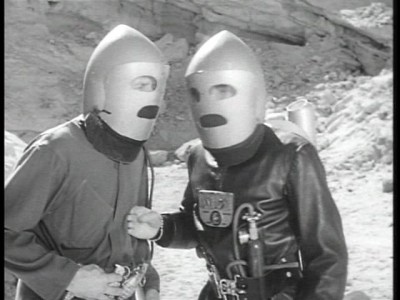 When a series of military targets are destroyed in the US, the government asks scientist Commander Cody (George Wallace) and his team to investigate. Using his newly invented flying suit, he discovers a group of men (well, two actually) who are helping pave the way for an alien invasion from the moon!
When a series of military targets are destroyed in the US, the government asks scientist Commander Cody (George Wallace) and his team to investigate. Using his newly invented flying suit, he discovers a group of men (well, two actually) who are helping pave the way for an alien invasion from the moon!
This serial just doesn't have the impact of the other two. Oh, it's alright, but it moves at a slower pace and the action isn't nearly as exciting. The fist fights have a tendency to go on a bit too long, and there are too many dialog scenes. The main problem with this is that the super-hero Commando Cody is battling some second rate thugs? That's not too exciting. The aliens play only a small role for most of the serial. Like the other two serials in this collection, the image quality was pretty good.
Captain Fathom (1955):
This is another pilot that has been all but forgotten. Captain Fathom in the inventor and captain of the atomic submarine Explorer, searches the seas for adventure. In this episode he detects a high amount of radiation coming from an unusual object. Written by Curt Siodmak, this was a pretty good show.
Captain Fathom (1965):
Captain Fathom was the third and final Syncro-Vox cartoon that Cambria Studios would release. Like their earlier shows, Clutch Cargo and Space Angel, this show had limited animation and used filmed mouth movements superimposed over static drawn images. The show revolves around Captain Bill Fathom and the crew of his submarine the Argonaut. Fathom, along with Cookie, Ronnie, Scotty, Miss Perkins, and Flip the dolphin, would get into trouble each week involving an unknown sea monster or lost treasure or both. As with Space Angel, the designs were by Alex Toth which means the show looks nice, even if the "animation" is horrid.
The episodes (sets of 5 five minute shows stitched together to form a complete story) are:
Ice Trap (A lot of color bleed.)
Pisastro's Private War (looks much better)
Ghost Ship
Most (if not all) of these shows are presented in two channel mono, which isn't too surprising given thier age. Most of the programs have some amount of background hiss or a hum, but even the worst examples weren't too bad. The dynamic range was never that impressive and a few shows were a bit muddled but over all the audio was acceptable.
Video:
These shows are all presented in their original full frame glory and look pretty decent. Keep in mind these are all shows that are in the public domain and as such there's no incentive for anyone to restore them. In general the images are soft and the level of detail isn't great, but the contrast is good over all and none of the shows are particularly horrible. The three serials are in surprisingly good condition and are among the best shows, video wise, in this set. The color episodes of Space Angel and Captain Fathom had some color bleed too. One nice thing is that there are no logos or 'bugs' in the corner of the shows with the exception (noted above) of the Rocky Jones shows.
Extras:
None.
Final Thoughts:
Whew! What a set. I have to admit that this is one of the most enjoyable collections I've had the pleasure to watch in a while. The shows range from fun and innocent to quite good and while there are a few duds most of the episodes are well worth watching. If you're a fan of SF TV this set is not to be missed. With so many rare pilots and seldom seen programs, and at such a reasonable price (especially if you look around a bit on line) this collection comes highly recommended.
Disc One - Flash Gordon (1954) - 12 episodes:
 Based on the popular comic strip, this show only lasted a single season, which is a little surprising. Though the production values were very low, they weren't significantly inferior to some of the other SF shows of the time that gained more fame.
Based on the popular comic strip, this show only lasted a single season, which is a little surprising. Though the production values were very low, they weren't significantly inferior to some of the other SF shows of the time that gained more fame. Oddly enough, this was an international co-production with German, French, and US companies picking up the tab. It was filmed in West Berlin and Marseilles, and it's interesting to see these cities so shortly after the conclusion of WWII. There were still many bombed out buildings to be seen in the background and it actually gave the show a unique look.
Though the characters are the same, the show departs from the Alex Raymond strip in a lot of ways. In this show Flash, Dale, and Dr. Zarkov are agents of the Galactic Bureau of Investigation and travel the universe battling evil doers in their space ship the Sky Flash.
The scripts are good and the program is a lot of fun.
The episodes included on this disc are (though not in this order):
Episode 1: Planet of Death
5. Akim the Terrible
6. The Claim Jumpers
8. The Breath of Death
10. Return of the Androids
17. Lure of Light
19. Race Against Time
20. The Witch of Neptune
21. The Brain Machine
22. Struggle to the End (3)
25. The Forbidden Experiment
And continued on Disc Two:
36. Deadline at Noon
39. The Subworld Revenge (The last episodes)
Space Angel (1962):
Set in the not too distant future, this SF children's program centers around Scott McCloud who is secretly the effeminate sounding Space Angel. He commands the space ship Starduster which is manned by Taurus, the mechanic with an unbelievable Irish accent, and Crystal the navigator/ science expert. On Earth is Dr. Mace, Crystal's father and the inventor of many of the gadgets that McCloud uses. He's available for a quick video-phone call when things get tight and always has the answer to any problems the crew faces.
 The program was presented in color, and was the second show to come from Cambria Productions. The company is best known for their so-bad-its-good 'cartoon' Clutch Cargo. That show was only a cartoon in the most basic sense. There was almost no animation at all. Instead of having to do to the cost and expense of animating lip movements, the lips of the voice actors were superimposed over the static facial images (using the company's patented Synchro-Vox technique.) Actor's hands would be filmed turning dials and opening doors, cardboard cutouts would slide across the frame to illustrate movement and cigar smoke was blown in front of the camera lens to create fog.
The program was presented in color, and was the second show to come from Cambria Productions. The company is best known for their so-bad-its-good 'cartoon' Clutch Cargo. That show was only a cartoon in the most basic sense. There was almost no animation at all. Instead of having to do to the cost and expense of animating lip movements, the lips of the voice actors were superimposed over the static facial images (using the company's patented Synchro-Vox technique.) Actor's hands would be filmed turning dials and opening doors, cardboard cutouts would slide across the frame to illustrate movement and cigar smoke was blown in front of the camera lens to create fog. Space Angel uses the same technique, but the people at Cambria improved the technique significantly after their experiences with Clutch. First and foremost they added make-up around the actor's lips to match the color of the drawn characters. The jarring, surreal white lips of Clutch were replaced with something that at least matched. They also de-emphasized the technique to a large extent, rarely showing the moving lips in close up. The final improvement was that they used the technique sparingly. The person talking was often facing away from the camera or had his mouth covered by a space helmet.
Initially run from 1962-64, this shows was surprisingly sophisticated given the time constraints and audience. The stories incorporated some real science on occasion (when landing on a planet in one episode, the crew leaves the mother ship in orbit and takes a lander down to the planet, a pretty advanced idea in 1962) and the plots, while simple, never talked down to children. The characters used futuristic terms realistically, as if they've been using them for years and never just added the term "space" in front of a word to make it sound advanced. Many SF shows at this time felt the need to define all of the terms in the same sentence that lead to awkward and unrealistic lines like "Hand me the space wrench, a tool that can open the stuck hatch in an instant!" Space Angel gets kudos for avoiding such muck.
This was a syndicated show, and each story was comprised of five episodes each running five-minutes. Stations could show one a day Monday through Friday or group them together and program them as a half-hour block. The stories presented here are stitched together into 30 minute episodes without the credits interrupting every few minutes.
The stories included in this set are:
Power Failure
Scratch One Chimp
The Gladiators
They Went That Away
Cosmic Combat
The Light Barrier
Expedition to a New Moon,
The Donovan Plan
Visitor from Outer Space
Climax (1955):
The set only has a single episode from this 1950's hour-long series, but what an episode: Dr. Jekyll and Mr. Hyde adapted by Gore Vidal and staring Michael Rennie (The Day the Earth Stood Still). Broadcast live, this rare kinescope is a great addition to anyone's SF TV collection.
The Star and the Story (1955):
The first episode of this 1/2 hour long drama is included, a story called The Dark Stranger staring Edmond O'Brien (The Barefoot Contessa for which he won an Oscar and the Film Noir classic D.O.A.) In this thriller O'Brien plays a writer who specializes in crime stories, but his fiction starts to ring true when his latest book starts to be played out, and he's in the role of the killer.
Disc Three and Four: Captain Z-RO (1955):
Like Flash Gordon, this was a very low budget Sci-Fi show that I really enjoyed. Located in a hidden laboratory somewhere on Earth, Captain Z-Ro (pronounced "Zero") conducted "experiments in time and space!" Though it was a SF show, the stories had a historical content, like early episodes of Doctor Who. In most cases Captain Z-RO would locate some nefarious plot in the distant past and go back in time to help the good guys. He saves the Pony Express from a rival stagecoach firm, helps get the Magna Carta signed, and they even aid a certain thief to escape from a trap set by the Sheriff of Nottingham.
 Occasionally the shows would have a more typical SF theme, such as when Z-RO invents a robot to explore the planet Mercury. Unfortunately a lightning strike right at the minute of transportation sends the robot to San Francisco instead of the nearby planet and scrambles its electronic brain in the process. Much of the show is taken up watching the robot walk around SF and occasionally causing trouble. Though the production values were very low (it looks like it was filmed in someone's decorated garage) the show had a lot of spirit and was fun to watch.
Occasionally the shows would have a more typical SF theme, such as when Z-RO invents a robot to explore the planet Mercury. Unfortunately a lightning strike right at the minute of transportation sends the robot to San Francisco instead of the nearby planet and scrambles its electronic brain in the process. Much of the show is taken up watching the robot walk around SF and occasionally causing trouble. Though the production values were very low (it looks like it was filmed in someone's decorated garage) the show had a lot of spirit and was fun to watch. This disc presents 24 or the 26 filmed episodes of this show. (Arrgh! So close!)
1: Christopher Columbus
2: Daniel Boone
3: Marco Polo
4: Benedict Arnold
5: King John
6: Magellan
7: Pony Express
8: William Tell
9: Roger the Robot
10: Blackbeard the Pirate
11: Attila the Hun
12: Robin Hood
13: Washington and Howe
15: Hernando Cortez
16: Molly Pitcher
17: Discovery of Gold
18: Meteor
20: Aztec Papers
21: Genghis Kahn
22: The Great Pyramid
23: Leonardo DaVinci
24: William the Conqueror
25: Adventure in Space
26: King Alfred
Disc Five:
The main reason I wanted to review this set is for the shows on this disc. There is a wonderful compilation of very rare shows and pilots, many that I had only heard about but never seen.
Here Comes Tobor (1956): This is the pilot for a proposed TV series based on the movie Tobor the Great. It was created by the same production company, Dudley Pictures, and many of the people who worked on the film contributed to this episode. The only person to appear in the movie and the series is the robot himself, Tobor, they carried the themes from the film over to the small screen. The large and powerful robot is controlled psychically by a small boy, and in this episode they have to rescue an atomic submarine that has been taken over by the enemy. It's corny but a lot of fun, sort of like the film itself.
Tales of Frankenstein (1958): This is another rare pilot that I had seen still from, but never the whole show. It was created by Hammer Films, and ironically featured a monster that looked at lot like Universal's Frankenstein monster.
 A terminally ill man and his wife travel to Dr. Frankenstein in search of his help. He's the only one who could possibly save the young man's life. Unfortunately the doctor has other plans. He needs a fresh, young brain for his creation, and if he just waits for a short while, the man who came seeking his aid will provide it.
A terminally ill man and his wife travel to Dr. Frankenstein in search of his help. He's the only one who could possibly save the young man's life. Unfortunately the doctor has other plans. He needs a fresh, young brain for his creation, and if he just waits for a short while, the man who came seeking his aid will provide it. This was a great show! It had an eerie atmosphere that was very reminiscent of the best Universal horror moves an intriguing plot that painted Dr. Frankenstein in a wonderfully evil light. After reading about this show in Famous Monsters decades ago, I was glad to finally get a chance to see it and very happy that it lived up to my expectations.
The Shadow - The Invisible Avenger (1958): This pilot tried to bring the popular pulp hero to the small screen, but failed. Running at about an hour, I'm sure it's the only two episodes that were filmed stitched together to make a B-level film. In this story Lamont Cranston (Richard Derr) and his mystic teacher Jogendra (Mark Daniels) head to New Orleans to find a missing friend. While there they stumble upon a plot to kill the leader of a rebellion against a South American dictator. There's some good jazz music in this film, and Derr did a good job as Cranston, but the story was very weak and there were more than a few plot holes. Overall this is a nice curiosity.
Clutch Cargo (1959) - This cartoon, if you can call it that, is famous for taking limited animation to a whole new level. There is virtually no traditional cell animation this show; instead human mouths are superimposed over drawn faces to 'animate' their speech. A program that has gone down in history as the absolutely worst looking cartoon ever, it's inclusion here is good for a laugh. You really have to see it to believe it.
In the adventure presented here, Operation Moonbeam, Clutch, Spinner, and the dog Paddlefoot pilot a rocket to the moon in order to win a lucrative rocket contract for one of their friends.
Johnny Jupiter (1953) - This is from the show's second incarnation that was broadcast on ABC (the first Johnny Jupiter was on the Dumont Network and though the creative cast was the same, the premise was altered significantly.) In this version Ernest P. Duckweather (Wright King) is a young inventor who works at the neighborhood hardware store. While tinkering in his lab one day, he manages to contact creatures (puppets) on the planet Jupiter, Johnny Jupiter, Major Domo, and Reject the Robot.
This was more of a sitcom than a SF show. In the single episode presented here Duckweather has to convince the host of a popular radio show to give a lecture to a local civics group. The host agrees, but when Duckweather finds out the man wants a $1000 fee, he dresses up as the famous speaker and goes on himself. The creatures from Jupiter play a minor role, giving Ernest advice when he needs it. Though the jokes weren't funny and the puppets pretty lame even for the time, it was an interesting show to watch.
Your Jeweler's Showcase: Operation E.S.P. (1952) - This is fun (and rare) program that stars Sheldon Leonard (Nick the bartender from It's a Wonderful Life) as Hardwick Harris. Harris is a hobo, riding the rails from location to location, but every Christmas Eve, no matter where he is, the local post office will have a general delivery letter for him containing $50. This year the sheriff finds it a little strange that Harris doesn't even know the name of the city he's in and yet has mail waiting. He runs him in, in a bid to keep his freedom Hardwick tells the story of a short order cook in a diner he once met who could see into the future.
This is a very fun and cute tale with a few good laughs. Yes, it's easy to see the ending way in advance, but just getting there is most of the fun.
 Thriller - The Return of Andrew Bentley (1961): Richard Matheson adapts a story by August Derleth in this excellent installment of the program that was hosted by Boris Karloff. John Newland stars as Ellis Corbett, a man summoned by his eccentric uncle. The man promises to leave Corbett his house, estate, and vast fortune if, and only if, Ellis will check his tomb every day and make sure it hasn't been opened. Ellis agrees, and that evening his uncle takes his own life. That's when Ellis' troubles begin as a black magician and his demon familiar are trying to steal his uncle's body for nefarious purposes. Dark, moody, and suspenseful, this episode is one of the best installments of Thriller I've seen.
Thriller - The Return of Andrew Bentley (1961): Richard Matheson adapts a story by August Derleth in this excellent installment of the program that was hosted by Boris Karloff. John Newland stars as Ellis Corbett, a man summoned by his eccentric uncle. The man promises to leave Corbett his house, estate, and vast fortune if, and only if, Ellis will check his tomb every day and make sure it hasn't been opened. Ellis agrees, and that evening his uncle takes his own life. That's when Ellis' troubles begin as a black magician and his demon familiar are trying to steal his uncle's body for nefarious purposes. Dark, moody, and suspenseful, this episode is one of the best installments of Thriller I've seen. The Shadow (1955): Another pilot for a Shadow TV show that never took off. Not quite as enjoyable as the 1958 version on this disc, but still fun. This time Lamont Cranston is a psychologist on retainer with the police department. Along with his girlfriend Margo Lane, Cranston investigates the Kimono murder. In this case a woman answers the door and is murdered. Her boyfriend is the prime suspect, but Lamont thinks something strange is going on.
This was a more standard police mystery with the Shadow only adding to it a bit. A good tyr, but one destined to fail.
Destination Space (1959): In this pilot Harry Townes plays Jim Benedict the engineer who both runs and designed America's first space station. When a solar flair causes significant damage to the station, Benedict has to travel back to Earth to fight congress for funds to keep the station operational.
This is one of those shows where you have to wonder what they were thinking. After a short but exciting opening when the station gets damaged, the next 20 minutes are spent watching Benedict trying to convince congressmen how important the space station is. Terribly boring and drawn out, it's no surprise that this wasn't picked up.
Stamp Day for Superman (1954): The cast and crew of The Adventures of Superman donated their services to the US Government for this half hour adventure. Lois is kidnapped and held by jewel thieves and it's up to Superman to save her and get to a high school in time for his appearance to sell US Saving Stamps.
Disc Six: One Step Beyond (1959-1961):
 An unlucky 13-episodes from this anthology series hosted by John Newland that explored the paranormal. Each story, supposedly true, revolves around a ghost or some psychic ability. This was never my favorite show and seeing these episodes once again reminds me why: The stories are pretty poor and the only thing that makes them interesting is the implication that they really happened. The wild coincidences make for poor drama, and if you have a hard time swallowing that psychic abilities really exist, there's not a lot that this show offers.
An unlucky 13-episodes from this anthology series hosted by John Newland that explored the paranormal. Each story, supposedly true, revolves around a ghost or some psychic ability. This was never my favorite show and seeing these episodes once again reminds me why: The stories are pretty poor and the only thing that makes them interesting is the implication that they really happened. The wild coincidences make for poor drama, and if you have a hard time swallowing that psychic abilities really exist, there's not a lot that this show offers. The episodes are:
The Sorcerer (with Christopher Lee... a small bit of footage seems to be missing)
Encounter
House of the Dead
Epilogue
The Stone Cutter
Contact
The Gift
Bride Possessed (the first episode)
The Burning Girl
The Premonition
Forest of the Night
Reunion
The Haunting
Where are They
Goodbye Grandpa
The Riddle
Discs Seven and Eight: Rocky Jones Space Ranger 23 episodes (1954):
 There is a good chunk of Rocky's adventures presented here, 23 out of the 39 filmed episodes. Set in the year 2054, Rocky, his co-pilot Winky (played by the tragic actor and former Our Gang star Scotty Beckett, later replaced by James Lydon (as Biff) when Beckett fled the country to avoid a weapons charge) and his pals Vena, Professor Newton and Bobby fly through space in their rocket ship protecting Earth from the evil mechanizations of villains such as Queen Cleolanthe of Ophiuchus who alternately wanted to kill Rocky and mate with him, and the evil Space Ranger Griff.
There is a good chunk of Rocky's adventures presented here, 23 out of the 39 filmed episodes. Set in the year 2054, Rocky, his co-pilot Winky (played by the tragic actor and former Our Gang star Scotty Beckett, later replaced by James Lydon (as Biff) when Beckett fled the country to avoid a weapons charge) and his pals Vena, Professor Newton and Bobby fly through space in their rocket ship protecting Earth from the evil mechanizations of villains such as Queen Cleolanthe of Ophiuchus who alternately wanted to kill Rocky and mate with him, and the evil Space Ranger Griff. This show is a lot like Space Patrol. The stories are simple but fun and while the scripts won't win any awards the program does bring out the kid in you. The special effects are actually quite good for a low budget show from the 50s too. My only regret is that all 39 episodes weren't included in this set.
There is a bug in the lower right hand corner, consisting of the Rocky Jones logo. Presumably this is to cover the source of the video.
The episodes included are:
Beyond the Curtain of Space Episodes 1-3 (where Rocky first meets Vena, Professor Newton and Bobby)
Escape into Space
Pirate of Prah 1-3
Crash of the Moons 1-3
Silver Needle in the Sky 1-3
The Forbidden Moon 1-3
Bobby's Comet 1-3
Rockey's Odyssey 1-3
Kip's Private War
Disc Nine: Phantom Empire Episodes 1-12 (Complete):
The three of the last four discs all contain movie serials. While these aren't technically TV shows, I'm not going to split hairs. The Phantom Empire is not the best serial to ever come out of Hollywood (that honor arguably goes to The Adventures of Captain Marvel) but it is one of my all-time favorites. This Mascot serial has it all, I guess they figured if they threw in everything including the kitchen sink everyone would be happy. As it is, the serial is a mess but a fun mess.
 Gene Autry stars as himself in his first staring role. He's the half-owner of Radio Ranch and has to broadcast a daily radio show from the ranch (which pretty much consists of him singing one song) or else he'll loose his land. When a professor and his daughter arrive at Radio Ranch looking for deposits of Radium, Gene agrees to help look and discovers the secret civilization of Murania, located 25,000 feet below ground. Murania is a technologically advanced country, the survivor of the lost island civilization of Mu, which is ruled by the voluptuous Queen Tika. When Tika finds out that Gene has discovered her country she orders her soldiers (and robots) to kill him. Add in some dishonest crooks who want the radium for themselves and you've got an exciting serial.
Gene Autry stars as himself in his first staring role. He's the half-owner of Radio Ranch and has to broadcast a daily radio show from the ranch (which pretty much consists of him singing one song) or else he'll loose his land. When a professor and his daughter arrive at Radio Ranch looking for deposits of Radium, Gene agrees to help look and discovers the secret civilization of Murania, located 25,000 feet below ground. Murania is a technologically advanced country, the survivor of the lost island civilization of Mu, which is ruled by the voluptuous Queen Tika. When Tika finds out that Gene has discovered her country she orders her soldiers (and robots) to kill him. Add in some dishonest crooks who want the radium for themselves and you've got an exciting serial. The thing I like about this adventure is the genre blending nature of the show. There are horse chases (with the Murania's looking like KKK members running off to a rally), robots, ray guns, aerial dog fights, and plenty of fisticuffs. Yes, it ludicrous when Gene sneaks into Murania and is about to discover something important only to announce "Hey guys we've got to get back to Radio Ranch and do the show or I'll loose the spread!" The only singing cowboy science fiction lost civilization serial ever made, it's well worth checking out. What makes this disc even better is that the picture quality is excellent, well above the other shows in this set.
Disc Ten: The Undersea Kingdom (1936) Chapters 1-12 (Complete):
 This was only the second serial Republic produced but it's clear that they knew what they were doing. Filled with action, adventure and excitement, The Undersea Kingdom is a classic.
This was only the second serial Republic produced but it's clear that they knew what they were doing. Filled with action, adventure and excitement, The Undersea Kingdom is a classic. The story, what little there is of it, involves top Annapolis student Crash Corrigan (Ray Corrigan who took the name "Crash" from this serial) going on a expedition with Professor Norton (C. Montague Shaw) in his newly invented atomic powered submarine to find the source of a series of recent earthquakes. A reporter, Diana Compton (Lois Wilde) tags along as does Norton's son Billy (Lee Van Atta) an assistant Joe (John Bradford) and Briny (Smiley Burnette) and Salty (Frankie Marvin), the comic reliefs.
Once under the sea they discover that the earthquakes are being caused by villains from the lost city of Atlantis. The fabled city is in the midst of a civil war between a war-like faction who wants to take over the surface world and the peace-loving group that just wants to leave things as they are. It's easy to tell these two groups apart because the war mongering faction wears black robes and the peaceful group wears white. It's up to Crash and his companions to make sure the white capes win and the stop the nefarious plans of the black capes.
While there are a lot of 'cheats' in this serial (as there are in Phantom Empire and Radar Men from the Moon) it's still a fun show. Just the idea of a ultra-advanced civilization that has harnessed nuclear power and created a race of robots going into battle on horseback and fighting with swords is great. Corny as hell, but it gives the opportunity for a lot of great horse stunts. I'll admit there were several times I was hoping that someone would shoot Briny and Salty, but nothing's perfect I suppose.
Disc Eleven:
Tales of Tomorrow (1951-53) 6 Episodes:
This is an excellent series that presented some solid SF stories every week. There's more SF than horror, and the tales weren't necessarily aimed at children. Test Flight was reminiscent of Heinlein's The Man Who Sold the Moon, concerning a man obsessed with being the first into space and therefore being able to control space travel. It has an interesting twist at the end. All of these episodes are good, (though Verdict in Space drags at the beginning) and worth owning.
 The episodes contained in this set are:
The episodes contained in this set are: Verdict in Space (the first episode)
Blunder
What We Need (a wonderful 'magical shop' story)
Age of Peril
Sneak Attack
Test Flight
Lights Out (1946-1952) 4 Episodes:
This long running series was one of a handful of shows to make the transition from radio to television and managed to snare some good writers and an impressive cast for most shows. The quartet of episodes included here are about average for the show, they'll hold your attention and it's fun to see some of the actors in early television. Unfortunately these were broadcast live and all that remains are kinetescopes. The image quality of these shows are below average for this set.
The episodes included are:
What Just Happened (with John Howard)
Curtain Call (Otto Kruger)
Man with the Watch (Francis L. Sullivan)
Passage Beyond
 G.E. Theater 2 episodes:
G.E. Theater 2 episodes: Hosted by Ronald Regan, this program ran for a decade and was one of the first early TV hits. The two stories presented here (the first one staring Reagan) aren't really SF, though the second one comes closest. In Let it Rain Reagan is a reported who stops into a small southern town for a short vacation and falls in love with a local girl. The Ballad of Mender McClure is a bit more interesting. A grumpy, mean, old man is given a jug full of a magical potion that will heal any illness. How does he use it, and how does it affect him? Vincent Price plays the devil and does a wonderful job.
Disc Twelve:
Radar Men from the Moon 12 episodes (1952):
This chapter play was produced at the end of the serial era and it's obvious that the glory days had passed. The first Commander Cody serial and reused the same outfit from an earlier Republic serial, King of the Rocket Men (1949). (It would be followed by "Commando Cody: Sky Marshal of the Universe" (1955). In between the suit would also star in "Zombies of the Stratosphere" (1952).) Unfortunately, that's not the only thing it reuses, as it includes a lot of stock footage from earlier serials too.
 When a series of military targets are destroyed in the US, the government asks scientist Commander Cody (George Wallace) and his team to investigate. Using his newly invented flying suit, he discovers a group of men (well, two actually) who are helping pave the way for an alien invasion from the moon!
When a series of military targets are destroyed in the US, the government asks scientist Commander Cody (George Wallace) and his team to investigate. Using his newly invented flying suit, he discovers a group of men (well, two actually) who are helping pave the way for an alien invasion from the moon! This serial just doesn't have the impact of the other two. Oh, it's alright, but it moves at a slower pace and the action isn't nearly as exciting. The fist fights have a tendency to go on a bit too long, and there are too many dialog scenes. The main problem with this is that the super-hero Commando Cody is battling some second rate thugs? That's not too exciting. The aliens play only a small role for most of the serial. Like the other two serials in this collection, the image quality was pretty good.
Captain Fathom (1955):
This is another pilot that has been all but forgotten. Captain Fathom in the inventor and captain of the atomic submarine Explorer, searches the seas for adventure. In this episode he detects a high amount of radiation coming from an unusual object. Written by Curt Siodmak, this was a pretty good show.
Captain Fathom (1965):
Captain Fathom was the third and final Syncro-Vox cartoon that Cambria Studios would release. Like their earlier shows, Clutch Cargo and Space Angel, this show had limited animation and used filmed mouth movements superimposed over static drawn images. The show revolves around Captain Bill Fathom and the crew of his submarine the Argonaut. Fathom, along with Cookie, Ronnie, Scotty, Miss Perkins, and Flip the dolphin, would get into trouble each week involving an unknown sea monster or lost treasure or both. As with Space Angel, the designs were by Alex Toth which means the show looks nice, even if the "animation" is horrid.
The episodes (sets of 5 five minute shows stitched together to form a complete story) are:
Ice Trap (A lot of color bleed.)
Pisastro's Private War (looks much better)
Ghost Ship
The DVD:
Audio: Most (if not all) of these shows are presented in two channel mono, which isn't too surprising given thier age. Most of the programs have some amount of background hiss or a hum, but even the worst examples weren't too bad. The dynamic range was never that impressive and a few shows were a bit muddled but over all the audio was acceptable.
Video:
These shows are all presented in their original full frame glory and look pretty decent. Keep in mind these are all shows that are in the public domain and as such there's no incentive for anyone to restore them. In general the images are soft and the level of detail isn't great, but the contrast is good over all and none of the shows are particularly horrible. The three serials are in surprisingly good condition and are among the best shows, video wise, in this set. The color episodes of Space Angel and Captain Fathom had some color bleed too. One nice thing is that there are no logos or 'bugs' in the corner of the shows with the exception (noted above) of the Rocky Jones shows.
Extras:
None.
Final Thoughts:
Whew! What a set. I have to admit that this is one of the most enjoyable collections I've had the pleasure to watch in a while. The shows range from fun and innocent to quite good and while there are a few duds most of the episodes are well worth watching. If you're a fan of SF TV this set is not to be missed. With so many rare pilots and seldom seen programs, and at such a reasonable price (especially if you look around a bit on line) this collection comes highly recommended.
|
| Popular Reviews |
| Sponsored Links |
|
|
| Sponsored Links |
|
|
| Release List | Reviews | Shop | Newsletter | Forum | DVD Giveaways | Blu-Ray | Advertise |
|
Copyright 2024 DVDTalk.com All Rights Reserved. Legal Info, Privacy Policy, Terms of Use,
Manage Preferences,
Your Privacy Choices | |||||||









